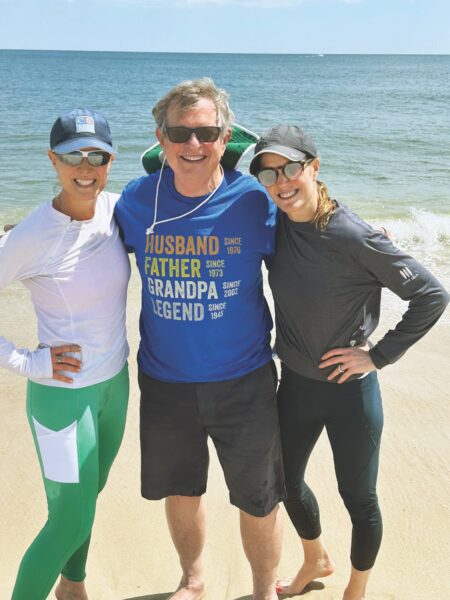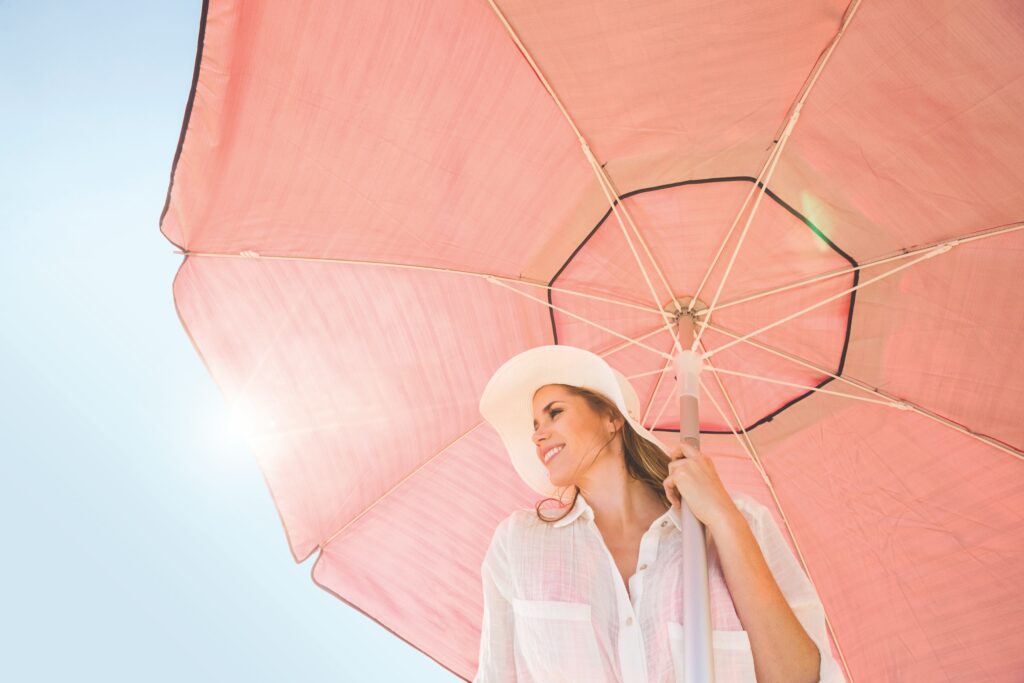Mike Kemp/Tetra Images/Getty Images
In the Pink: An umbrella with a UPF rating, plus a hat and clothing, help protect skin from UV damage.
Sunscreen is always a major part of the sun protection equation, but there are many other clothing and accessory options you can mix and match to create the best possible coverage. Here’s our guide to find what’s best for you.
You may feel sun-smart when you go to the beach wearing sunscreen, a hat and a rash guard, all while sitting under an umbrella. But what about dancing at an outdoor wedding, spending the day at the office or even taking a Sunday drive? If you wear a daily moisturizer with sunscreen, that’s a good start, but you could be doing more to protect your exposed skin from damaging, cancer-causing ultraviolet (UV) rays.
“It’s a daily conversation with our patients,” says Elizabeth K. Hale, MD, a dermatologist and Mohs surgeon in New York City. “People think about sun protection when they’re on vacation or they’re going to the beach or pool, but they’re not necessarily thinking about the incidental exposure from running errands, walking to work, leaving the office at lunchtime or going to their kids’ games.”
The options for this type of protection go way beyond sunscreen. There are many types of clothing, hats, eyewear, shade structures and more to keep you covered while looking cool. We tapped Dr. Hale and her sister, Julie K. Karen, MD, who practice together at CompleteSkinMD on the Upper East Side of New York City, to share their expert sun-style tips to keep you protected from head to toe for all your outings. The two specialize in skin cancer and the treatment of sun damage, and they practice what they preach!
What Are You Doing Today?
No matter what’s on your agenda, you need a sun-protection plan. Find yours below!
Running errands:
A 2023 large-scale survey on application habits and practices of sunscreen users in the U.S. found that, on average, they only applied it if they planned to be outside for at least three hours on sunny days. The problem with this thinking is that sun damage is cumulative, so over time, even those few minutes of unprotected sun during your walk to your kids’ bus stop or across the parking lot at a shopping center can lead to premature skin aging and even skin cancer.
“You might not get sunburn — which is mainly caused by ultraviolet B (UVB) rays from the sun — on days you’re not spending a lot of time outside,” Dr. Hale explains. “You are getting hit, though, with ultraviolet A rays (also called UVA), which are longer wavelengths that penetrate through windows and clouds year-round. Those are the ones that contribute to tanning, hyperpigmentation, skin aging and also to skin cancer.” Daily sunscreen is a crucial start, but you can also cover your bases by packing a foldable, sun-protective, wide-brimmed hat in your bag to protect your scalp, face and neck in a pinch.
“Even basic things like walking on the shady side of the street will help,” Dr. Hale adds. Chic parasols and compact sun umbrellas are becoming more mainstream and are excellent ways to shield your skin from the sun (think a family walk in your local botanical gardens). “When I see someone carrying one, I think, ‘Oh, they’re smart!’” Not every hat or umbrella fabric provides good UV protection, so look for a UPF label or look for The Skin Cancer Foundation Seal of Recommendation.
Did You Know? You Can Bring Your Own Shade!
Shade is an important part of your sun protection plan, but you can’t always count on being near a shady tree or a gazebo when outside. You can, however, make your own shade — and carry it with you, so you’re never caught unprotected. “Telling people to seek shade is such a simple but effective message, and now there are many cool ways to do it,” says Elizabeth Buzney, MD, a dermatologist at Brigham and Women’s Health in Boston and Chestnut Hill, Massachusetts, and a member of The Skin Cancer Foundation Photobiology Committee. “Foldable bucket hats, UPF-rated umbrellas and parasols and foldable (and stakeless!) beach tents and sails that fit in your beach bag are all easy ways to shield your skin from UV rays while enjoying time outside.”
Going for a drive:

Elizabeth K. Hale, MD, and Julie K. Karen, MD, are sisters who practice dermatology together and do volunteer skin screenings together (seen here on the RV at a Destination Healthy Skin stop).
You may not think about sun protection inside a car, but you get UVA exposure there, too. The front windshield, which is much thicker glass than the rest of your vehicle windows, is treated to filter out these rays, but the side windows are not. A famous case published in The New England Journal of Medicine in 2012 shows a photo of a 69-year-old man who had driven a truck for 28 years. The left (driver’s) side of his face shows a remarkable amount of sun damage, while the other side looks far less wrinkled.
How can you shield your skin or that of your kids and other passengers from those UVA rays? You can have window film that blocks UV radiation installed on your vehicle windows and sunroof (see box, below.) Or consider shades that can be installed on your vehicle’s windows. “I have those built into my car, and I don’t even have young kids anymore,” says Dr. Karen. “Some car manufacturers offer this option because it’s unpleasant to have the sun in your eyes, but the shades also provide UV protection.”
Dr. Hale says that if you drive long distances regularly (like the trucker mentioned above), you may also want to purchase driving gloves to protect your hands. But if you’re going to and from the office or taxiing kids around town, slather broad-spectrum sunscreen on your hands and any other exposed skin. Keeping a stick sunscreen product in your bag can be “handy” for this.
Protecting eyes from UV light while driving is important, too. “You can get acute inflammation and even sunburns on your eyes that can lead to vision impairment, pain and skin cancer in your eye or on the eyelids,” says Dr. Karen. Applying sunscreen to delicate lid skin is tricky, so sunglasses serve an essential purpose beyond being fashionable. Look for a pair with UVA/UVB protection and a broader frame to provide more lateral eye coverage. If you’re prone to melasma (brown patches on the skin induced by sun exposure) or have sensitive skin, Dr. Karen suggests avoiding metal-framed glasses. “Melasma is aggravated by UV exposure and intense heat,” she says. The metal frames can amplify sun exposure and heat the skin, which may contribute to brown spots.
Going to an outdoor soirée:

Dr. Hale and Dr. Karen, with their father, practicing what they preach at the beach, in sun-protection gear!
Outdoor events and weddings call for dressy attire, which may mean exposed décolleté, back and arms. How can you balance sun protection and looking chic? Fortunately, advances in UPF clothing mean you no longer have to choose between fashion and function. You can find on-trend blouses and dresses made with UV protection.
To maximize the benefits, you ideally want full-coverage styles. “The beauty of sun-protective clothing is that it’s more potent than sunscreen, so it negates the need for sunscreen on skin covered by the fabric,” says Dr. Karen. But if you’re wearing a sleeveless shift dress with UPF 50, you still need sun protection on your arms, such as sunscreen or even a shawl. “A lightweight shawl might only provide minimal sun protection, but it’s better than nothing,” says Dr. Hale. For a little extra protection before outdoor events, Dr. Hale suggests taking an antioxidant supplement with ingredients including fern extract (Polypodium leucotomos), nicotinamide and carotenoids. You still need sunscreen on any exposed skin, but these vitamins may help prevent worse damage.
A note to those hosting an outdoor party: Consider displaying a basket of sunscreen offerings, with different types of formulas for guests to use. “There are spritzer sprays designed to go over makeup that are great for reapplying,” says Dr. Hale. Also, book a venue with (or provide your own) shade structures — tents, gazebos, pergolas, etc. — to offer guests some respite from the sun.
Did You Know UPF Clothing Has Evolved?
An ultraviolet protection factor (UPF) rating tells you how much UV radiation gets through that fabric to reach your skin. For example, a UPF 50 fabric blocks 98 percent of the sun’s rays and allows 2 percent (1/50th) to penetrate, thus greatly reducing your exposure. A fabric must have a UPF of at least 30 to qualify for The Skin Cancer Foundation Seal of Recommendation. When UPF fabrics were first introduced, they didn’t always breathe or have the style you would wear off the trail or out of the pool. “But if you haven’t tried the latest UPF clothing or hats, give them a try,” suggests Anna Chien, MD, a dermatologist in Baltimore and member of The Skin Cancer Foundation Photobiology Committee. “High-tech innovations have made fabrics that are breathable and moisture-wicking. Now you can get the high-UPF sun protection that is similar to wearing dark, tight-knit fabrics (such as not-ideal-for-summer denim) in styles that feel light and breezy and look cute enough to be worn for lunch at an outdoor café.”
Working in the office:
Sitting inside at a desk all day seems low risk compared with a day at the pool, and it is. However, if you sit near a window that isn’t treated to protect against UV radiation, you are incurring sun damage. You can talk to your employer about investing in window film at the office or have it installed on your windows at home. Otherwise, apply a broad-spectrum sunscreen on exposed skin. Look for a tinted formula that blocks high-energy visible light (also known as HEV or blue light), outside and from electronic devices and office lighting, which can trigger hyperpigmentation and melasma. And stash some sun protection supplies at your desk for lunchtime walks: a powder sunscreen for easy reapplication, a hand cream with SPF, a hat or a parasol.
Did You Know That Window Film Counts as Sun Protection?
If window film conjures up images of dark and mysterious tinted car windows, allow us to shed some light on one of its biggest misconceptions: “People perceive all window film as dark and something you can hardly see through, but there are many different types of films — and some don’t have any tint at all,” says Lisa Winckler, a longtime expert in the window film industry and consultant for the International Window Film Association. “However, they all contain UV absorbers.”
UV protection wasn’t initially put into the film for your skin’s benefit. It’s there to protect the polyester material the films are made of, so it can effectively cut glare and reduce heat in your car, home or office. But because the UV absorbers do a pretty good job of blocking UVA rays (unlike UVB rays, UVA penetrates through untreated glass), it’s an effective source of sun protection for your skin, too. The films also filter visible light, which can contribute to pigmentation. “Window film protects up to 380 nanometers (the agreed measurement upper limit of the UVA range), which is on par with sunglasses that have UV protection,” says Winckler. They even qualify for The Skin Cancer Foundation Seal of Recommendation, and there are many that carry the Seal.
Being active outside:
That sunscreen survey we mentioned also showed that Americans are doing a decent job of applying sunscreens on sunny beach days, with a whopping 99 percent of sunscreen users doing so, but reapplication rates dip to 80 percent, and only one-third of people reapply it on cloudy days. It’s important to remember that any time spent outdoors yields UV exposure, whether it’s sunny or overcast or whether you’re at the pool, a soccer game, an outdoor wedding or going for a hike through a forest.
“I often have patients come in on a Monday with a terrible sunburn, and they’ll say they were at a doubleheader baseball game. It’s no different than being at the beach all day,” says Dr. Karen. “You have to take the same precautions: a liberal application and reapplication of sunscreen, a hat and other protective clothing and accessories. And if there is a shady spot available, head there to watch the game.”
Remember to be prepared for anything outdoors. “I often see patients on Mondays who say, ‘I didn’t think it was going to be sunny, but it was,’ or ‘But it was cloudy,’” says Dr. Hale. (Remember that clouds don’t stop UVA rays.) Even if you don’t think you’ll be outside much, pack a wide-brimmed hat and a lightweight cardigan with UPF 50 to throw over a tank top. “You never know when it will stop raining or if your kid will make it into the tournament finals, and you’ll be outside all day. Play it safe!”




